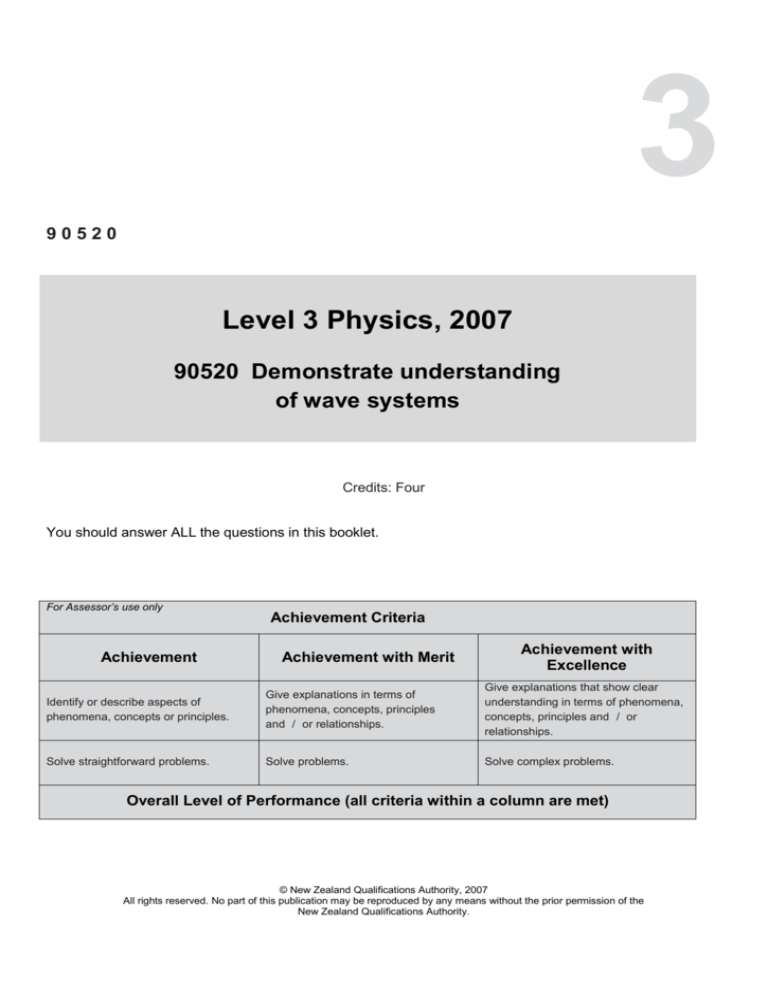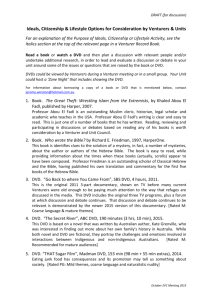
3
90520
Level 3 Physics, 2007
90520 Demonstrate understanding
of wave systems
Credits: Four
You should answer ALL the questions in this booklet.
For Assessor’s use only
Achievement
Achievement Criteria
Achievement with Merit
Achievement with
Excellence
Identify or describe aspects of
phenomena, concepts or principles.
Give explanations in terms of
phenomena, concepts, principles
and / or relationships.
Give explanations that show clear
understanding in terms of phenomena,
concepts, principles and / or
relationships.
Solve straightforward problems.
Solve problems.
Solve complex problems.
Overall Level of Performance (all criteria within a column are met)
© New Zealand Qualifications Authority, 2007
All rights reserved. No part of this publication may be reproduced by any means without the prior permission of the
New Zealand Qualifications Authority.
For copyright reasons, this resource cannot be reproduced here.
You are advised to spend 35 minutes answering the questions in this booklet.
You may find the following formulae useful.
d sin n
n
dx
L
f' f
v
W
vW vS
v f
f
1
T
QUESTION ONE: STANDING WAVES
The speed of sound in air is 3.40 102 m s1.
Carlie plays the recorder. The recorder can be modelled as an open pipe. On one occasion, the note Carlie
plays has the following standing wave pattern for one of its overtones (harmonics). The length of the pipe
when she plays this note is 28.5 cm.
(a)
Calculate the wavelength of the standing wave shown in the diagram.
wavelength =
(b)
Which harmonic (or overtone) is shown in the diagram above?
harmonic
(c)
OR
overtone
By first calculating the wavelength that the fundamental standing wave would have in this length of
pipe (or otherwise), calculate the frequency of the fundamental standing wave.
frequency =
L3 Physics 90520, 2007 – page 2 of 5
(d)
Explain how the fundamental standing wave is produced in this pipe.
Opening or closing holes along the length of the pipe can produce different frequency notes.
Carlie first plays a note with all holes closed. She then opens the last hole.
(e)
Explain how the frequency of the note produced will change.
QUESTION TWO: THE DOPPLER EFFECT
The speed of sound in air is 3.40 102 m s1.
Carlie plays her recorder on a float in a local parade. Carlie’s friend Edward is in the crowd listening to
Carlie play. At one point in the performance, Carlie plays the same note for several seconds.
(a)
Explain why, as the float travels towards Edward at a constant speed, the pitch of the note heard by
Carlie is different to the pitch of the note heard by Edward.
When the float is traveling at 1.2 m s1, the apparent frequency of the note that Edward hears is 673 Hz.
(b)
Re-arrange an appropriate formula to find an expression for the true frequency of the source, and use
this re-arranged formula to calculate the frequency of the note Carlie plays.
frequency =
(c)
Even though there is only a small difference in these two frequencies, explain why neither Carlie nor
Edward hear beats in this situation.
Fale is further down the street and hears a different part of the performance. As the float passes Fale, the
apparent wavelength of a note he hears when the float is moving towards him changes to a different apparent
wavelength when the float is moving away from him. The difference in the apparent wavelengths (λ'moving
towards and λ'moving away) of the note he hears is 0.0032 m.
The apparent wavelength, λ', in the Doppler effect can be calculated from:
vw vs
vw
'
(d)
If the speed of the float is still 1.2 m s1 as it passes Fale, calculate the frequency of the note emitted by
the recorder.
frequency =
L3 Physics 90520, 2007 – page 3 of 5
QUESTION THREE: DIFFRACTION GRATING
The band Carlie plays in has produced a DVD of its performances. When looking at the DVD, Carlie sees a
spectrum “reflected” from the surface of the DVD. The diagram below shows a first order spectrum being
produced when white light is shone on to the DVD perpendicular to its surface.
The DVD can be modelled as a diffraction grating. On a DVD, lines are drawn on the surface. The distance
between the lines is called the track spacing. The track spacing on the DVD is equivalent to the slit spacing
of a diffraction grating.
(a)
Which colour light is seen “reflected” at the smallest angle in the spectrum?
The smallest angle at which green light is seen is 49.8°. Green light has a wavelength of 5.65 107 m.
(b)
(i)
Show that the spacing of the tracks on the DVD has an unrounded value of 7.3973 107 m.
(ii)
Round this answer to the correct number of significant figures.
track spacing =
A CD produces spectra in the same way that a DVD produces spectra. The track spacing on a DVD is less
than that on a CD.
(c)
The angle at which violet light (wavelength 438 109 m) forms its first bright fringe when
“reflected” from a CD is 20.4 less than the angle of the first bright fringe of violet light “reflected”
from a DVD.
L3 Physics 90520, 2007 – page 4 of 5
Calculate the track spacing on a CD.
track spacing =
(d)
More spectra are produced using a CD than a DVD.
Explain why. (Calculations are not required.)
L3 Physics 90520, 2007 – page 5 of 5








